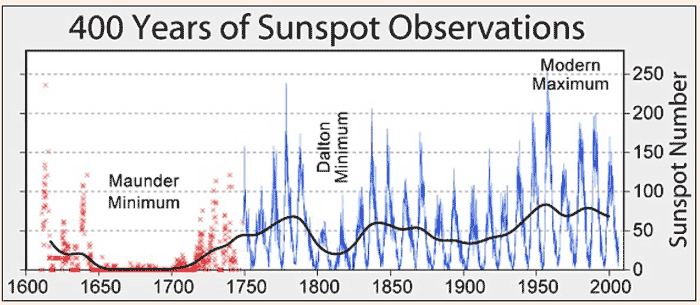The world may or may not be doomed to severe impacts from coming global warming caused by human-produced greenhouse gases, but we're quite likely to endure a min-ice age first, a group of European researchers says.
At a presentation at the recent National Astronomy Meeting, Professor Valentina Zharkova of the UK's Northumbria University says research has cracked the code for predicting solar cycles - and that between 2020 and 2030 a pair of solar cycles will in effect cancel each other out, just as opposite radio waves can do, greatly reducing heat from the sun.
The result: a "mini-ice age," caused by something called the Maunder Minimum, when solar flares become increasingly rare. When last seen from in the years 1645 and to about 1715, it became exceedingly cold, such that London's Thames River froze for one of the relatively few times in history (the last occurrence was in 1814).
Predictions from the model suggest that solar activity will fall by 60% during the 2030s, ushering in a decade of cold weather globally.
In the 11-year solar cycle starting in 2030, two solar energy waves in opposite hemispheres of the Sun will exactly mirror each other, the researchers say, peaking at the same time.
"We predict that this will lead to the properties of a Maunder Minimum," Zharkova said at the conference.
It is 172 years since a scientist first spotted that the sun's activity varies over a cycle lasting around 10 to 12 years, the UK's Daily Mail reports.
But every cycle is a little different and none of the models of causes to date have fully explained the fluctuations. But now Zharkova and her colleagues say they have solved that challenge, and will be able to predict solar cycles with a high degree of accuracy, including predictions for this coming cooling period.
Sunspots became Very Low in Last Maunder Minimum

Over the 11-year cycle, energy waves fluctuate between the northern and southern hemispheres of the Sun. Combining both waves together and comparing to real data for the current solar cycle, the researchers found that their predictions showed an accuracy of 97%, according to Zharkova.
Is Zharkova right? Does this change the global warming debate at all? Who knows, but the global warming science is hardly precise. Maybe this model will be.
Do you think these researchers may have cracked the code for solar cylces? How would a new mini-ice age in 15 change the debate on global warming? Let us know your thoughts at the Feedback button below.

|